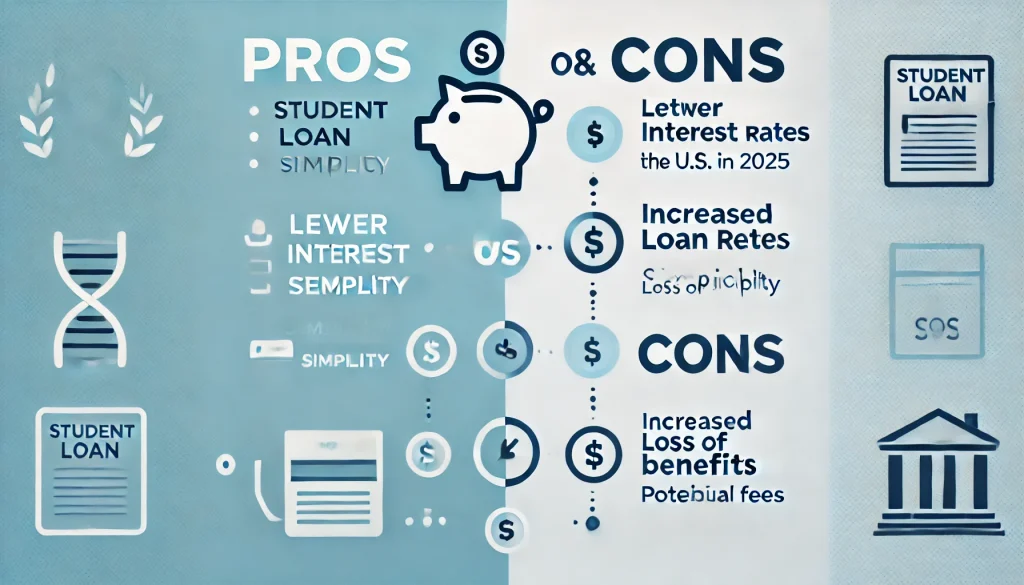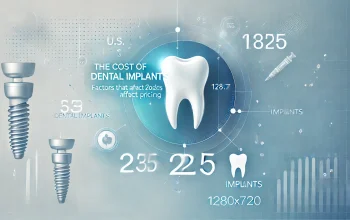The Pros and Cons of Student Loan Consolidation in the U.S. in 2025

As student loan debt continues to be a pressing issue for many Americans, student loan consolidation remains a popular option for managing and reducing this debt. In 2025, understanding the benefits and drawbacks of student loan consolidation can help borrowers make informed decisions about their financial future. This comprehensive guide explores the pros and cons of student loan consolidation, providing valuable insights for those considering this option.
Table of Contents
What is Student Loan Consolidation?
pros and cons of student loan consolidation involves combining multiple federal or private student loans into a single new loan. This process simplifies repayment by merging several loans into one, often with a single monthly payment. In the U.S., borrowers can choose between federal Direct Consolidation Loans and private consolidation options, each offering different terms and conditions.
The Pros of Student Loan Consolidation
1. Simplified Repayment Process
One of the most significant advantages of pros and cons of student loan consolidation is the simplification of the repayment process. By consolidating multiple loans into one, borrowers only need to manage a single payment each month. This streamlined approach can reduce the risk of missed payments and help borrowers stay organized.
2. Potential for Lower Monthly Payments
pros and cons of student loan consolidation can potentially lower monthly payments by extending the repayment term. While this may result in paying more interest over the life of the loan, the reduced monthly payments can ease financial strain and improve cash flow. This is particularly beneficial for borrowers facing financial challenges.
3. Access to Alternative Repayment Plans
Consolidating federal pros and cons of student loan through a Direct Consolidation Loan opens the door to various repayment plans, including Income-Driven Repayment (IDR) plans. IDR plans adjust monthly payments based on income and family size, making them a flexible option for borrowers with fluctuating incomes.
4. Eligibility for Loan Forgiveness Programs
Federal pros and cons of student loan consolidation can make borrowers eligible for loan forgiveness programs. For instance, borrowers who consolidate their loans into a Direct Consolidation Loan may qualify for Public Service Loan Forgiveness (PSLF) if they work in qualifying public service jobs and make qualifying payments.
5. Fixed Interest Rates
Federal student loan consolidation offers the benefit of a fixed interest rate. The interest rate for a Direct Consolidation Loan is the weighted average of the interest rates on the loans being consolidated, rounded up to the nearest one-eighth percent. This provides stability and predictability in monthly payments.
The Cons of Student Loan Consolidation
1. Loss of Borrower Benefits
One potential drawback of student loan consolidation is the loss of certain borrower benefits associated with the original loans. For example, borrowers may lose access to loan forgiveness programs, interest rate discounts, or principal rebates that were available on individual loans.
2. Extended Repayment Terms
While extending the repayment term can lower monthly payments, it also means borrowers will pay more in interest over the life of the loan. This extended term can result in significantly higher overall repayment amounts, which may not be ideal for those seeking to minimize total debt.
3. Impact on Credit Score
Consolidating loans can impact a borrower’s credit score, particularly if the process involves missing payments or applying for new credit. While consolidation itself does not directly affect credit scores, managing a single loan responsibly is crucial to maintaining a healthy credit profile.
4. Ineligibility for Certain Repayment Plans
Not all repayment plans are available for consolidated loans. For instance, private student loan consolidation may not offer the same range of repayment options as federal consolidation. Borrowers should carefully review available plans to ensure they select the one that best meets their needs.
5. Potential for Higher Interest Rates
In some cases, consolidating private student loans may result in higher interest rates compared to the original loans. Private lenders may offer different terms and conditions, and borrowers should compare rates and fees before proceeding with consolidation.
Federal vs. Private Student Loan Consolidation
When considering student loan consolidation, borrowers must choose between federal and private options. Each type of consolidation offers distinct advantages and limitations.
Federal Student Loan Consolidation
Federal student loan consolidation is conducted through a Direct Consolidation Loan, which is offered by the U.S. Department of Education. Key features include:
- Eligibility: Available for most federal student loans, including Direct Loans, Federal Family Education Loans (FFEL), and Perkins Loans.
- Interest Rate: The interest rate is a weighted average of the existing loan rates, rounded up to the nearest one-eighth percent.
- Repayment Plans: Offers access to various repayment plans, including Income-Driven Repayment (IDR) plans.
Private Student Loan Consolidation
Private student loan consolidation, also known as private refinancing, is offered by private lenders. Key features include:
- Eligibility: Available for private pros and cons of student loan and sometimes federal loans, depending on the lender.
- Interest Rate: Rates can be fixed or variable and may vary based on the borrower’s creditworthiness and market conditions.
- Repayment Plans: Repayment options are determined by the private lender and may be less flexible than federal options.
How to Decide if Student Loan Consolidation is Right for You
Deciding whether to consolidate student loans involves evaluating personal financial situations and long-term goals. Consider the following factors:
- Current Loan Terms: Review the terms of existing loans, including interest rates, repayment schedules, and borrower benefits.
- Financial Goals: Determine whether lowering monthly payments or seeking loan forgiveness aligns with financial objectives.
- Loan Types: Assess whether federal or private consolidation best suits the type of loans held.
- Long-Term Impact: Calculate the potential total cost of consolidation, including interest and fees.
Conclusion
pros and cons of student loan consolidation can be a valuable tool for managing and reducing debt, but it’s essential to weigh the pros and cons carefully. In 2025, borrowers must consider their individual circumstances and financial goals when deciding whether to consolidate. By understanding the benefits and limitations of both federal and private consolidation options, borrowers can make informed decisions that support their long-term financial well-being.
For personalized advice, consult a financial advisor or student loan expert to explore the best consolidation strategy for your situation. Whether aiming for simplified payments, lower monthly costs, or access to repayment plans, pros and cons of student loan consolidation offers various pathways to achieve financial stability and success.


